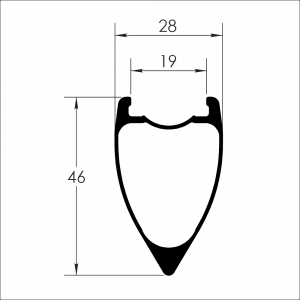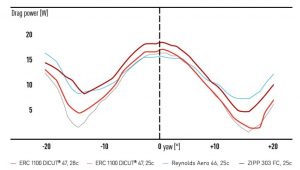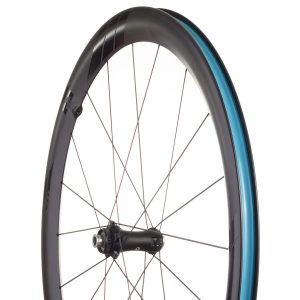REYNOLDS AERO 46 DB – FAST, STIFF WHEELS BEST FOR ROAD RACERS

If you are afraid of heights, people tell you “don’t look down”.
If being on trend is important to you, I’ll give you the same advice when it comes to the Reynolds Aero 46 DB carbon disc wheelset.
However, if road speed unperturbed by crosswinds is more important, just look forward, pedal and smile.
 Reynolds has stuck with a classic, V-nose design for the spoke edge of these wheels and added a somewhat toroid shaped rim profile heading to the other edge where the rim meets the tire for the 46, 65 and 80mm deep disc and rim brake wheels in its Aero line. This, when it seems like the world of carbon bike wheels have gone to blunt nose, U-shaped rim profiles.
Reynolds has stuck with a classic, V-nose design for the spoke edge of these wheels and added a somewhat toroid shaped rim profile heading to the other edge where the rim meets the tire for the 46, 65 and 80mm deep disc and rim brake wheels in its Aero line. This, when it seems like the world of carbon bike wheels have gone to blunt nose, U-shaped rim profiles.
For me, Reynolds’ design definitely works to produce and maintain my speed. While I did find myself looking down riding these wheels, it was to see my speed and power output rather than the rim profile. With the Aero 46 DB it felt like I was riding faster than normal in the same power ranges I normally ride.
My experience is, of course, anecdotal rather than scientific. Interestingly, I came across the wind tunnel chart below of tests done by DT Swiss. It compares the aero drag of their ERC 1100 Dicut DB wheels, designed by the Formula One aero engineers of SwissSide they regularly tout, against Reynolds Aero 46 (blue line) and Zipp 303 Firecrest (grey line) wheelsets.
About 80% of our road riding is done when the wind is coming from a 0 to 10-degree angle (or “yaw”) and 50% is done between 0 and 5 degrees based on field testing done by Flo Cycling.
Unfortunately, DT Swiss didn’t specify whether the Reynolds or Zipp wheels are rim or disc brake or current or older models. It is kind of important as Reynolds only makes the Aero 46 in a disc brake version now and the current Aero 46 DB (introduced in 2017, the same year as the ERC 1100 Dicut DB wheels) are wider and likely more aero than the earlier Aero 46 DB and rim brake versions.
Same goes for the Zipp 303 Firecrest whose DB and rim brake wheel profiles are quite different and have each gone through serious redesigns in the last couple of years.
Based on when the DT Swiss wheels were being designed and wind tunnel tested, my guess is that they are benchmarking the ERC 1100 against older models of the Reynolds and Firecrest rim brake wheels.
Regardless, it’s interesting to see the Reynolds Aero 46 held up as a benchmark in the same way the Firecrest has for years (but no longer should be as the NSW has surpassed it).
The second aero consideration is how well a deeper wheel does in managing side or crosswinds. Much of the reason for the move to the blunt nose design was to… uh… blunt those crosswinds and keep riders from having to steer against the wind and constantly modify their line or get blown off the road.
Well, that design clearly works. Wheels like the blunt nose Zipp NSWs in road disc and rim brake versions at various depths are better than the old Firecrest used to be. (The new Firecrest rim brake wheels have first gen NSW rims; the Firecrest disc brake wheels have more traditional Firecrest rim shape, i.e., not great in crosswinds.)
But, my experience with the Aero 46 DB found them as good in crosswinds as the NSW despite a very different design. I rode 100 miles and 10,000 feet on the Reynolds wheelset in the Vermont mountains on a horrible rainy day with swirling winds coming at me from seemingly every direction and often when I was crawling up steep passes or “gaps” as they call them up there. Weighing a mere 150lbs/68kg, I notice crosswinds as much as anyone.
My mind and body were truly miserable in the rain and wind of this ride but the Aero 46 DB wheels were totally unphased by either.
That reminded me of what I often remind you: focus on performance rather than the specs or design hype (though Reynolds does hype their rim profile as crosswind beaters).
On to other performance considerations…
The stiffness and rolling smoothness of this wheelset is good though not without a few characteristics I don’t care for.
Both in and out of the saddle I find these Reynolds wheels plenty stiff. After many rides the wheels remain true and I’ve found the spokes are all still tensioned. But when I crank out big watts (for me) going up steep hills, I occasionally hear the spokes ping.
I’ve flexed the spokes by hand and heard the pings but can’t tell whether they are coming from the ends of these straight-pull spokes in the flanges or rims, from rubbing against each other in the cross pattern, or from rubbing against the inside edge of the rim where the spoke passes through to reach the internal nipples. My guess is that it is the latter.
Whatever it is, it is a little disconcerting to hear these pings when you are cranking it out going uphill even though, as mentioned, the wheels ride stiff and have remained true.
They also ride very smoothly on the Torch hub internals supplied by Industry Nine. That said, much like the Chris King hubs, the i9s make a distinctive, loud freehub noise. Zing zing zing zing.
 While I know it is popular with some, I personally don’t care for freehub zinging. You attract attention coasting down a road and you can annoy or even anger someone pulling their legs off in front of you to hear you freewheeling behind them. Sometimes it’s an invitation to drop you.
While I know it is popular with some, I personally don’t care for freehub zinging. You attract attention coasting down a road and you can annoy or even anger someone pulling their legs off in front of you to hear you freewheeling behind them. Sometimes it’s an invitation to drop you.
While my personal bias against occasional spoke and freehub noise doesn’t affect these otherwise stiff and smooth rolling wheels, I found the compliance or comfort of the 46 Aero DB to be their weak link.
I ran this road disc wheelset tubeless with both 25C and 28C Zipp Tangente Speed RT and Schwalbe Pro One tires on it to try to find the best combination of comfort, speed, and handling. No matter, I couldn’t get beyond average compliance with any of these.
As the chart above and others like it show, wider tires increase aero drag. On the flip side, wider tires reduce rolling resistance, can improve handling, and allow you to ride at lower pressures to improve comfort.
So there are tradeoffs and you have to consider and tire choice decisions based on what you prioritize among those trade-offs.
For example, when you start riding at aero speeds (18-20 mph/29-32kph and up), the reduction in aero drag of a narrower tire far outweighs the increase in rolling resistance. Don’t ride that fast and care about comfort more than anything? Put on wider tires because your rolling resistance will be lower, comfort will be greater and you won’t be going fast enough to affect your aero performance.
Assuming, though, that you are looking to ride at aero speeds on these aptly named Reynolds Aero 46 DB wheelset (and the other wheelsets in this carbon disc wheelset category), know that only 25C tubeless tires measure narrower than the 28.2mm wide rims at the “brake track” and have a 28.6mm max width. The Zipp Tangente Speed tires measure 25.8 mm wide and Schwalbe Pro One measures 27.5 mm, both at 80 psi, the max pressure you’d want to run tubeless tires on 19C rims even if you weigh 200lbs/80kg. 28C tires measure wider than the outside width of the rims.
I didn’t measure them with tubed clincher tires. From my experience with other 19C rims, the benchmark 25C Continental Grand Prix 4000S II at 100psi measures very similarly to the Schwalbe Pro One at 80psi. Both measure wider than other popular tubeless and tubed clinchers.
With the 25C Zipp Tangente Speed road tubeless inflated to 65 psi where I run my tubeless tires, the Aero 46 DB weren’t comfortable. Tolerable, yes. Comfortable no. If I were racing, I’d go with these tires both for their width on these wheels but also because they handle beautifully and have other performance attributes that caused me to pick them as the best in my review of tubeless tires.
If I weren’t racing but looking to do fast group rides and get better comfort along with speed, I’d go with the 25C Schwalbe Pro One. The compliance is OK with those tires, on par with many, and the handling no worse. I wouldn’t, however, recommend you do “gravel” or dirt road riding with these wheels unless you went to a 28C tire.
In The Know Cycling supports you by doing hours of independent and comparative evaluations to find and recommend the best road cycling gear and kit to improve your riding experience.
You can support the site and save yourself time and money when you buy through the links in the posts and at Know’s Shop to stores I rank among the best for their low prices and high customer satisfaction, some which pay a commission that helps cover our review and site costs.
Click here to read about who we are, what we do, and why.
You can compare key performance and other criteria of this wheelset against other all arounders in my post The Best All Around Carbon Disc Wheelset.

Steve:
Have you ridden or done a review on SHIMANO C 40 DISC BRAKE WHEELS?
Bob
Bob, I haven’t. May I ask, what interests you about those Shimano wheels? Steve
hi steve. i’m also curious about the fact you don’t seem to include shimano wheels in your tests. i do lots of road racing in italy and have been using shimano dura-ace c50/60 wheels for years (i see they are used by quite a few pro teams too).
i find them to be a great blend of bulletproof reliability, quality, clean aesthetics, reasonable price, performance and longevity. some wheels are lighter, some faster, some sexier, but i have found the dura-ace wheels to be the best overall package for handling the intense pressure and abuse of racing over the long haul. real workhorses that are plenty fast and can handle anything, which gives me the peace of mind to completely focus on the racing!
just my data point.
cheers,
ferdinando
the only thing I want to say is that the pros ride on shimano tubulars which, if you look closely are wider that the clincher versions. not to mention that a tubular wheel is a little bit different to a non-tubular one.
Bob, Fernando, Andrei, Thanks for your comments. There’s a short and longer answer to why I haven’t reviewed Shimano wheels of late. The short answer is that Shimano wheels haven’t kept pace with the advances others have over the last several years. I’ll share the specifics and my speculation as to why in a longer comment in my Know’s Notes this Friday. Steve
Steve,
Are there many differences between these wheels and your previous Reynolds best value wheels ( Assault)?
Tomas, Yes. They perform very differently. The Assaults aren’t as fast, are susceptible to crosswinds, and are more comfortable. On the design side, the Assaults are a good deal narrower and heavier and use a very different rim profile. And, of course, they are priced quite differently. They share the same brand name but after that, there are few similarities. The Aero 46 DB are third generation performance wheels while the Assaults are second generation value wheels. I expect that Reynolds will soon offer a newer Assault DB wheelset as they make one called the LE (for limited edition) only available on Canyon bikes. Steve
Hi Steve,
Have you seen hambini’s aero test?
https://www.hambini.com/blog/post/bicycle-wheel-aerodynamics-which-one-is-fastest/
Velt, Thanks. Looks like a lot in there. I’ll have to read that a few times to take it all in. Steve
Hi there, really enjoy your blog! Wondering if you’ve ridden the 2016 46mm Reynolds Aero rim-brake clincher w. the DT Swiss hubs? Also, I saw on Twitter you were trying out the AR41 disc and non-disc in October. Both of these wheels are ~$1100-$1200 this week and I know the Reynolds Assault were a previous recommendation of yours.
– I really like the DT Swiss hubs in my Bontrager RXL wheels, looks like they are on the Aero 46’s but not the AR41x’s.
– CTG2 on the AR41x is a draw if it helps with heat build up on long descents, but marketing claims aside will I notice any differences in a panic stop vs the 46 Aero if a car turns right in front of me on a 40mph descent?
I’m a ~175lbs B-group rider in Western Mass, with several ~300-800′ climbs on mostly 50-70 mile rides.
Thanks in advance!
Horation. Answers: No, I’ve not ridden the 2016 Aero 46 rim brake wheelset. No, I wouldn’t recommend the AR41 disc and rim brake wheels. CTG2 is about better heat resistance but has no effect on braking power or distance.
I love riding in Western Mass especially Mount Greylock. You could use any of these wheels on those downhills without fear of frying your wheels AS LONG AS you don’t drag the brakes on them. (read this section of my climbing wheels review for more about proper carbon wheel braking technique). That said, most 2016 model year carbon rim brake wheelsets and current model year low priced carbon rim brake wheelsets don’t brake nearly as quickly or confidently or with as much feel (aka modulation) as current models of $2000 and up wheelsets from the likes of Zipp, ENVE, Bontrager, Mavic, Campy and a few others. You get what you pay for. Steve
Greylock is great – come out for a ride with the Northampton Cycling Club sometime next summer! Thanks for your answers – maybe I should just stick with the RXLs on my Emonda for now. Based on your review of the 46 Aero DB I was thinking the 46 Aero rim brake version might be an under-loved find at $1100 (original MSRP $2500) but it sounds like the current gen of carbon clinchers are superior for braking distances and feel. I’d love a set of XXX4’s but a bit too pricey, well above 40% of my bike’s cost.
Can you elaborate on your “no, would not recommend the AR41”? is that due to weight? ride? something else? I was about to go with the AR41 Disc, but am concerned about the Reynolds reputation for overly stiff ride characteristics.
Jim, take a look at my review of the AR41 in this review of lower-priced carbon wheels. I rode the AR41 Disc at the same time and had the same reaction. Steve
Congratulations on what you do. I’m glad I found you. I have a question. I reynolds assault limited edition L.E. (canyon slx). They are suitable for 95 kg. I’m athletic and strong, not fat. I feel the flex climb. What is your opinion? Do I go like this? Are you talking louder, maybe? Thank you very much.
Giurgiu, The Assault LE is a stiff wheelset. They should not flex much while climbing even with 95kg. If yours flex, you should check the spoke tension. Steve
Would you recommend reynolds aero 65 db or 46 db ? Is there any big difference between the two? I typically ride around 35-37kph and i like to attack and sprint !
Eric, The Aero 65 DB would be better on the flats and in sprints whereas the Aero 46 DB is more of an all-around, road racing and variable terrain wheelset. Here’s my review of the Aero 65 DB for comparison. https://intheknowcycling.com/reynolds-aero-65-db/ Steve
Thanks steve !
Steve,
In the past I’ve heard Reynolds can be a nightmare mounting tubeless tires. I know it seems like a little deal but since owning the first generation of assaults (before tubeless was an option) I’ve steered away from them because I have heard this often about Reynolds road tubeless. What has been your experience with the black labels?
Thanks for the review Steve,
I would like to see how you compere this pair against the Aeolus RSL 51
Hi Mariano. You can find that comparison here. Cheers, Steve
I saw it the review in the morning. I think I invoked the review yesterday xD. Thnks for sharing your wheel experience.